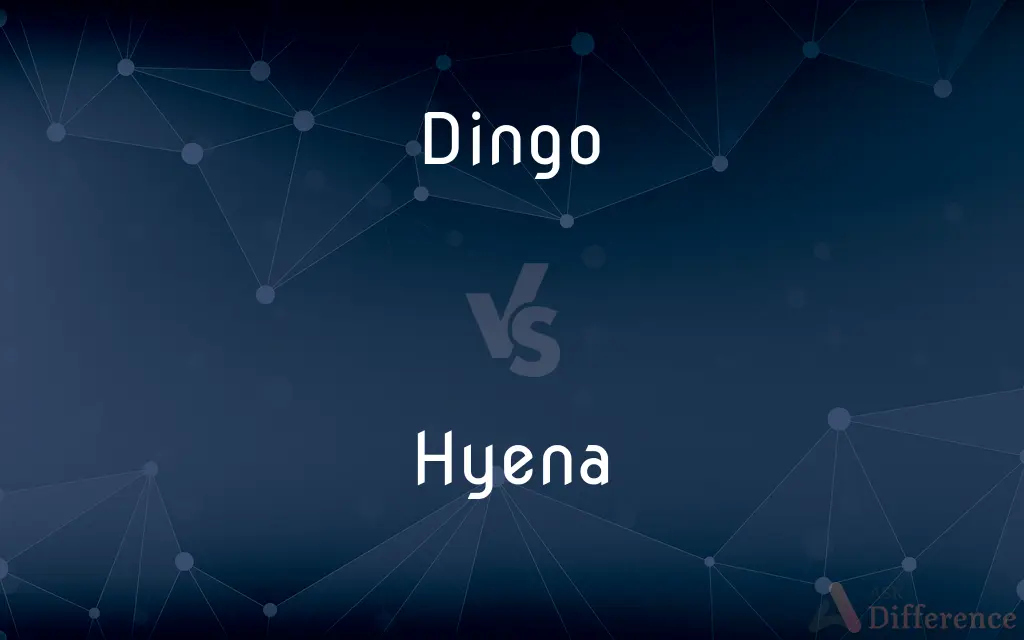Dingo vs. Hyena — What's the Difference?
By Fiza Rafique & Urooj Arif — Updated on April 24, 2024
Dingoes are wild canids native to Australia, known for their distinct howl, while hyenas are larger, more robust African mammals recognized for their unique laughing sounds.

Difference Between Dingo and Hyena
Table of Contents
ADVERTISEMENT
Key Differences
Dingoes, classified as Canis lupus dingo, are primarily found in Australia and are considered apex predators in their ecosystems. They are closely related to domestic dogs but have evolved unique traits for survival in diverse environments. On the other hand, hyenas, particularly spotted hyenas, inhabit various African landscapes and are more closely related to cats than to dogs, despite their dog-like appearance.
Dingoes typically exhibit a sandy to reddish-brown coat, which helps them blend into the desert and forest landscapes of Australia. Conversely, hyenas are known for their coarse fur with distinctive spots or stripes that provide camouflage in the grassy plains and forests of Africa.
Social structures differ significantly between the two species. Dingoes often form small, flexible social groups, which can vary greatly in size depending on environmental conditions. In contrast, hyenas are known for their complex social systems, with clans that can include up to 80 individuals, governed by a strict hierarchy.
Regarding vocalizations, dingoes are famous for their mournful howls, which are used to communicate with pack members over large distances. Hyenas, meanwhile, are best known for their laughs, which are actually vocalizations that communicate excitement or frustration within their clans.
Dietarily, both dingoes and hyenas are opportunistic feeders, but dingoes primarily hunt small to medium-sized mammals and occasionally participate in communal hunts. Hyenas, on the other hand, are adept scavengers with powerful jaws capable of crushing bones, though they also hunt large animals in groups.
ADVERTISEMENT
Comparison Chart
Taxonomy
Canis lupus dingo, related to domestic dogs
Subfamily Hyaenidae, closer to felines
Native Habitat
Australia
Africa
Physical Appearance
Sandy to reddish-brown coat
Coarse fur with spots or stripes
Social Structure
Small, flexible groups
Large, complex clans with strict hierarchy
Vocalization
Howls
Laughs (complex vocalizations)
Compare with Definitions
Dingo
Known for their distinctive howl, used for communication.
The haunting howl of a dingo can be heard at dusk.
Hyena
Found predominantly in Africa, adapting to various ecosystems from savannahs to forests.
The spotted hyena thrives in the Serengeti.
Dingo
A wild dog native to Australia known for its adaptability to various environments.
The dingo is often spotted in the Australian outback.
Hyena
A member of the Hyaenidae family, known for its powerful scavenging ability.
Hyenas can crush bones with their strong jaws.
Dingo
A solitary or pack-living animal, depending on environmental conditions.
A dingo pack may collaborate to hunt larger prey.
Hyena
Exhibits complex social behavior, forming large matriarchal clans.
Female hyenas dominate the social structure of the clan.
Dingo
Not a breed of domestic dog, but a distinct species of wild canid.
Dingoes lack the genetic markers that define domesticated dogs.
Hyena
Often misrepresented as merely scavengers, though they are skilled hunters.
Hyenas actively hunt prey in coordinated packs.
Dingo
Subject to conservation efforts due to habitat loss and hybridization.
Conservationists are working to protect the pure dingo lineage.
Hyena
Characterized by distinctive vocalizations interpreted as laughter.
The laugh of a hyena often signals competition.
Dingo
The dingo (Canis familiaris, Canis familiaris dingo, Canis dingo, or Canis lupus dingo) is an ancient (basal) lineage of dog found in Australia. Its taxonomic classification is debated; as per the variety of scientific names presently applied in different publications, it is variously considered a form of domestic dog not warranting recognition as a subspecies; a subspecies of dog or wolf; or a full species in its own right.
Hyena
Hyenas, or hyaenas (from Ancient Greek ὕαινα, hýaina), are feliform carnivoran mammals of the family Hyaenidae . With only four extant species (in three genera), it is the fifth-smallest biological family in the Carnivora and one of the smallest in the class Mammalia.
Dingo
A wild dog (Canis lupus subsp. dingo) of Australia and Southeast Asia, having a reddish-brown or yellowish-brown coat.
Hyena
A doglike African mammal with forelimbs that are longer than the hindlimbs and an erect mane. Hyenas are noted as scavengers but most are also effective hunters.
Dingo
A wild dog native to Australia (Canis familiaris, Canis familiaris dingo, Canis dingo, or Canis lupus dingo).
Hyena
Any of several carnivorous mammals of the family Hyaenidae of Africa and Asia, which feed as scavengers and have powerful jaws, relatively short hind limbs, and coarse hair.
Dingo
A cowardly or otherwise despicable person.
Hyena
Any of the medium-sized to large feliform carnivores of the subfamily Hyaenidae, native to Africa and Asia and noted for the sound similar to laughter which they can make if excited.
Dingo
A wild dog found in Australia, but supposed to have introduced at a very early period. It has a wolflike face, bushy tail, and a reddish brown color.
Hyena
Any carnivorous mammal of the family Hyænidæ, doglike nocturnal mammals of Africa and southern Asia, of which three living species are known. They are large and strong, but cowardly. They feed chiefly on carrion, and are nocturnal in their habits.
Dingo
Wolflike yellowish-brown wild dog of Australia
Hyena
Doglike nocturnal mammal of Africa and southern Asia that feeds chiefly on carrion
Common Curiosities
What is the primary habitat of a dingo?
Dingoes are predominantly found in the diverse landscapes of Australia, including deserts, forests, and grasslands.
Are dingoes considered domestic animals?
No, dingoes are wild canids and are not domesticated, although they are closely related to domestic dogs.
How do hyenas communicate within their clans?
Hyenas use a variety of sounds, including groans, yells, and laughter-like noises, to communicate social status and emotional states.
What types of prey do hyenas hunt?
Hyenas hunt a variety of prey, including large mammals such as wildebeest and antelope, often using teamwork.
How do the hunting techniques of dingoes differ from those of hyenas?
Dingoes often hunt alone or in small groups, focusing on smaller prey, while hyenas can hunt in large groups targeting much larger animals.
Can dingoes and hyenas interbreed?
No, dingoes and hyenas cannot interbreed as they belong to different families and genera.
What are the conservation statuses of dingoes and hyenas?
Dingoes are considered vulnerable due to habitat loss and hybridization, whereas hyena conservation statuses vary by species but include concerns about habitat encroachment and hunting.
What role do dingoes play in Australian ecosystems?
Dingoes play a crucial role as apex predators, helping to maintain the balance of species and control populations of herbivores and smaller predators.
What are the typical group sizes for dingoes and hyenas?
Dingo groups can vary widely, but hyena clans are typically large, sometimes consisting of up to 80 individuals.
Why are hyenas often misunderstood in popular culture?
Hyenas are often portrayed negatively due to myths and misconceptions about their scavenging habits, overshadowing their complex social structures and efficiency as predators.
Share Your Discovery

Previous Comparison
Hypoglycemia vs. Hyperglycemia
Next Comparison
Ionization vs. DissociationAuthor Spotlight
Written by
Fiza RafiqueFiza Rafique is a skilled content writer at AskDifference.com, where she meticulously refines and enhances written pieces. Drawing from her vast editorial expertise, Fiza ensures clarity, accuracy, and precision in every article. Passionate about language, she continually seeks to elevate the quality of content for readers worldwide.
Co-written by
Urooj ArifUrooj is a skilled content writer at Ask Difference, known for her exceptional ability to simplify complex topics into engaging and informative content. With a passion for research and a flair for clear, concise writing, she consistently delivers articles that resonate with our diverse audience.














































